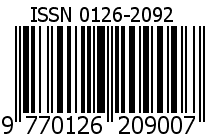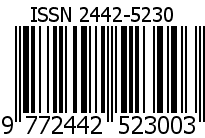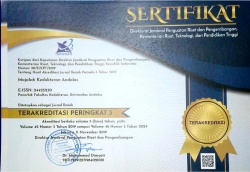Hubungan Ekspresi PD-L1 dengan Stadium Patologis dan Grading Karsinoma Urotelial Kandung Kemih
Abstract
Objective: To determine the relationship between Programmed Cell Death-Ligand 1 (PD-L1) expression with histopathological variants, and staging of papillary thyroid carcinoma. Methods: This study is an observational research with a cross-sectional study. The sample consisted of papillary thyroid carcinoma cases from the Pathological Anatomy Laboratory of Dr. M. Djamil Padang General Hospital, spanning from January 2022 to December 2022, totaling 37 cases. Pathological stages of invasive urothelial carcinoma of bladder were assessed based on the TNM system WHO 2022 classification, and grades were evaluated according to the WHO 2022 classification. PD-L1 expression was assessed through immunohistochemical staining. Bivariate analysis was conducted using the Chi-square test, with statistical significance set at p < 0.05. Results: The study revealed a positive PD-L1 expression rate of 32.5%. Statistical analysis showed a significant association between PD-L1 expression and pathological stages of invasive urothelial carcinoma of bladder (p=0.019). High stages exhibited higher levels of PD-L1 expression. However, the study did not find a significant relationship between PD-L1 expression and grades of invasive urothelial carcinoma of bladder (p=0.152). Conclusion: There is an association between PD-L1 expression and pathological stages. PD-L1 expression is not associated with the grades of invasive urothelial carcinoma of bladder.
Keywords
Full Text:
PDFReferences
Ghate K, Amir E, Kuksis M, et al. PD-L1 expression and clinical outcomes in patients with advanced urothelial carcinoma treated with checkpoint inhibitors: A meta-analysis. Cancer Treat Rev. 2019;76(January):51-56. doi:10.1016/j.ctrv.2019.05.002
Sung H, Ferlay J, Siegel RL, et al. Global Cancer Statistics 2020: GLOBOCAN Estimates of Incidence and Mortality Worldwide for 36 Cancers in 185 Countries. CA Cancer J Clin. 2021;71(3):209-249. doi:10.3322/caac.21660
Supit W, Mochtar CA, Santoso RB, Umbas R. Outcomes of radical cystectomy and bladder preservation treatment for muscle-invasive urothelial carcinoma of the bladder. Asian J Surg. 2014;37(4):184-189. doi:10.1016/j.asjsur.2014.01.010
Kanker di Indonesia Tahun 2014 Data Histopatologik. jakarta: Badan Registrasi kanker Perhimpunan Dokter Spesialis Patologi Indonesia; 2018.
Miyazaki J, Nishiyama H. Epidemiology of urothelial carcinoma. Int J Urol. 2017;24(10):730-734. doi:10.1111/iju.13376
Williamson SR, Al-Ahmadie HA, Cheng L. WHO Classification of Tumours of The Urinary System and male Genital Organs. 5th edition. Lyon: International Agency for research On cancer (IARC); 2022.
Zhou H, Guo CC, Ro JY. Urinary Bladder Pathology.; 2021. doi:10.1007/978-3-030-71509-0
Perix VK, Suryanti S, Sihombing AT. Five Years Facts of Bladder Cancer at West Java’s Top Referral Hospital, in Indonesia. Althea Med J. 2017;4(1):94-99. doi:10.15850/amj.v4n1.1028
Kadir MNNA, Hairon SM, Yaacob NM, Manan AA, Ali N. Survival and characteristics of bladder cancer: Analysis of the malaysian national cancer registry. Int J Environ Res Public Health. 2021;18(10). doi:10.3390/ijerph18105237
Abdih MA, Djatisoesanto W, Hardjowijoto S. Profile of Bladder Transitional Cell Cancer in Soetomo Hospital Surabaya. Indones J Urol. 2014;21(2):1-6. doi:10.32421/juri.v21i2.31
McConkey DJ, Choi W. Molecular Subtypes of Bladder Cancer. Curr Oncol Rep. 2018;20(10):1-7. doi:10.1007/s11912-018-0727-5
Kwon WA, Seo HK. Optimizing frontline therapy in advanced urothelial cancer. Transl Androl Urol. 2020;9(3):983-985. doi:10.21037/tau.2020.04.03
Audisio M, Buttigliero C, Turco F, et al. Metastatic Urothelial Carcinoma: Have We Take the Road to the Personalized Medicine? Cells. 2022;11(10):1-9. doi:10.3390/cells11101614
Wang DR, Wu XL, Sun YL. Therapeutic targets and biomarkers of tumor immunotherapy: response versus non-response. Signal Transduct Target Ther. 2022;7(1). doi:10.1038/s41392-022-01136-2
Jiang X, Wang J, Deng X, et al. Role of the tumor microenvironment in PD-L1/PD-1- mediated tumor immune escape. Mol Cancer. Published online 2019:1-17.
Gong J, Chehrazi-Raffle A, Reddi S, Salgia R. Development of PD-1 and PD-L1 inhibitors as a form of cancer immunotherapy: A comprehensive review of registration trials and future considerations. J Immunother Cancer. 2018;6(1):1-18. doi:10.1186/s40425-018-0316-z
Eckstein M, Cimadamore A, Hartmann A, et al. PD-L1 assessment in urothelial carcinoma: a practical approach. Ann Transl Med. 2019;7(22):690-690. doi:10.21037/atm.2019.10.24
Wen Y, Chen Y, Duan X, et al. The clinicopathological and prognostic value of PD-L1 in urothelial carcinoma: a meta-analysis. Clin Exp Med. 2019;19(4):407-416. doi:10.1007/s10238-019-00572-9
Huang Y, Zhang SD, McCrudden C, Chan KW, Lin Y, Kwok HF. The prognostic significance of PD-L1 in bladder cancer. Oncol Rep. 2015;33(6):3075-3084. doi:10.3892/or.2015.3933
Syaebani M, Rinonce HT, Ferronika P.Mada UG. Ekspresi PD-L1 Pada Karsinoma Urotelial Kandung Kemih: Kajian Berdasarkan Umur, Jenis Kelamin, Invasi Otot dan Metastasis Limfonodi.Universitas gadjah Mada. Published online 2021:0-1.
Al Nabhani S, Al Harthy A, Al Riyami M, et al. Programmed Death-ligand 1 (PD-L1) Expression in Bladder Cancer and its Correlation with Tumor Grade, Stage, and Outcome. Oman Med J. 2022;37(6). doi:10.5001/omj.2022.96
Wahid S, Miskad UA. Imunologi lebih mudah dipahami. Diandra Primamitra. 2017
Saginala K, Barsouk A, Aluru JS, Rawla P, Padala SA, Barsouk A. Epidemiology of Bladder Cancer. Med Sci (Basel, Switzerland). 2020;8(1):1-12. doi:10.3390/medsci8010015
Omorphos NP, Carlo J, Piedad P. Guideline of guidelines : Muscle-invasive bladder cancer. 2021;47:71-78. doi:10.5152/tud.2020.20337
Dwi A, Rinonce TA, Ferronika P. Hubungan Ekspresi PD-L1 dengan Grading Tumor, Indeks Proliferasi, Dan Tumor- Infiltrating Lymphocytes (TILs) Pada Karsinoma Urotelial Kandung Kemih. Mada UG. Published online 2021:0-2.
Zhao M, He X lei, Teng X dong. Understanding the molecular pathogenesis and prognostics of bladder cancer : an overview. 2016;28(1):92-98. doi:10.3978/j.issn.1000-9604.2016.02.05





















